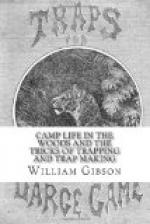Deer are hunted at all seasons of the year, but ought not to [Page 219] be hunted during the summer. The sport legitimately begins in September, when the buck begins to harden his horns, and when his flesh is in its best condition for food. In October the deer is more shy, and during this month and after, the sport is at its height. The deer should be skinned from an incision down the belly, and the hide spread on a hoop stretcher, page 275.
THE MOOSE.
We have already given so much space to the hunting of the deer that we shall be obliged to cut short our remarks on the Moose, particularly as it is a representative of the same family. This animal is the largest of the Deer tribe, being seven or eight feet in height and often weighing over fifteen hundred pounds. It is supplied with immense flat spreading horns, sometimes expanding to the distance of six feet between the tips. It is found in Maine, Oregon and Washington Territories, and in the neighborhood of the great lakes, and inhabits the regions as far [Page 220] north as the Arctic Sea. Its color is yellowish brown. The fur is thicker in winter than summer, and on the neck of the animal the hair is very coarse and hangs in an immense tuft of over a foot in length. The flesh is most excellent food and is much esteemed by trappers. The habits of the moose are in most respects identical with the deer, already described, and like them they form “yards” during the winter season.
[Illustration]
In the North the moose is hunted on snow-shoes by the natives, and in summer they are shot like the deer. They are often very dangerous and terrible creatures to hunt, and the utmost care and skill, as described in regard to the deer, is required on the part of the hunter in order to avoid detection through the exquisite sense of smell which the animal possesses. The moose is easily trapped. The Newhouse, No. 6, is especially adapted for the purpose, and it should be chained to a clog of stone or wood of over fifty pounds in weight. Set the trap in the “yard,” or beneath the snow where the moose frequents, or in the summer, or fall seasons, as described for the deer, using the same methods in regard to baiting, etc.




